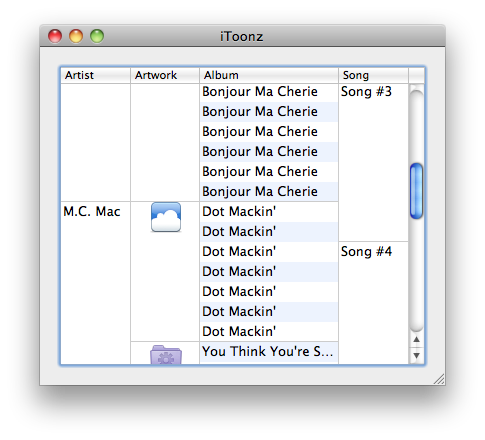Yet Another Way to Mimic the Artwork Column in Cocoa
I was just turned on to a post from Jesper of Waffle Software entitled How to Mimic the Artwork Column in Cocoa. There he approaches the problem of implementing cells in an NSTableView that can span multiple rows. This spurred on Jacob Xiao at Like Thought to tackle the problem in a different manner. I suggest reading both of the above to get a sense of the problem and the possible approaches.
With NSTableView still on my mind from my last diversion, this got me thinking about the problem and I decided to try my own hand at it. I preferred Jacob’s approach as I think it should be all contained within NSTableView if at all possible. I liked the notion of “slicing” up the cell instead of using another view. Playing with it, I came up with a generalized solution. Here are some of the interesting aspects:
- It can support any NSCell subclass. I do this by using a special wrapper cell. It draws the “full” version of the cell then draws out the slices for each row into the tableview.
- It determines the spans by finding contiguous rows that have the same object value for the column in question.
- The above two points are exploited to do some caching such that the “full” cell is only drawn once and the parts composited in place as needed.
- If the first column is set to span rows, it will only draw the grid for the last row in a span.
- You can designate multiple columns to do this. In the example project, if you click on the “Album” column, it will toggle between span and non-span mode. The “Artwork” column doesn’t do this because it looks cruddy in non-span mode.
I haven’t tested it(see update below) but theoretically, the spans do not have to line up between different columns.
To use it, for any columns you want to have this row-spanning behavior, set the table column class to NoodleRowSpanningTableColumn. Also, it might help to get rid of any intercell spacing in your tableview (at least in the vertical direction). There are probably a few bugs. I do know that reordering columns may cause some grid drawing funniness but for the most part, it seems to work pretty well. Let me know if you find otherwise.
You can check the code for other implementation tidbits. I’ve included a self-contained project below but I’ll eventually polish it a bit and add it to my NoodleKit repository where it can join the rest of my goodies.
Many thanks for Jesper and Jacob for the inspiration and laying down the groundwork for this.
Update (Oct. 21, 2009): I observed odd behavior in that the program would get into a re-drawing frenzy eating up a bit of CPU. This was non-blocking in that I was still able to manipulate the UI (which is why I didn’t notice it at first). I finally figured out that it was the -drawGridInClipRect implementation. I was drawing the grid selectively by changing the grid mask and then calling super on subregions. Unfortunately, changing the grid mask queued up a redraw which started a loop (albeit one that didn’t tie up the event loop). Seeing as I needed to fix the grid-drawing logic anyways, I reworked the whole thing.
The new grid code should now be able to handle multiple spanning columns rearranged in whatever way you want. Here’s contrived example of having multiple spanning columns that don’t necessarily line up:

I also made some other fixes and improvements so it’s worth re-downloading the project even if you already did so before (I bumped this version to 0.37).
As for integration with the rest of NoodleKit, I still need to decide whether I want to merge this with my sticky row tableview to make some über-tableview. Problem is is that I can’t think of how the two features would interact so maybe it’s best to keep them separate. Thoughts on this are welcome.
Update (Oct. 23, 2009): I’ve just updated the project to version 0.68. There was a crasher when you would click on a non-span row and then move into a spanning cell. Also, the span cells were highlighting when you clicked on a non-span row. Both of these have been fixed. Thanks for Jesper for finding the crasher and Jacob for helping with the fix.
Update (Oct. 25, 2009): I’ve consolidated this functionality along with my previous sticky row header code into a single NoodleTableView class. You can find it in the NoodleKit repository. Future updates to this will be posted there from here on out.
Download NoodleRowSpanningTableViewTest.zip
[This project is no longer being updated here. You can get the latest in the NoodleKit repo]
Category: Cocoa, Downloads, OS X, Programming, Software, User Interface 2 comments »
October 20th, 2009 at 10:49 pm
Cool idea! I like how you implemented it as a wrapper around any arbitrary kind of cell.
October 21st, 2009 at 10:54 am
Hey Jacob, thanks for working out the approach of slicing up the cell. I’m not sure it would have been my first approach so it’s nice to see someone showing it can be done. In the end, I thought it was neat seeing a bit of ad-hoc “research” going on between devs. Makes me think we should have more of these blog-chain type things to tackle odd problems.